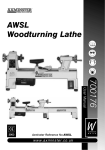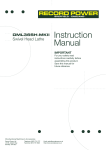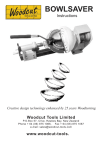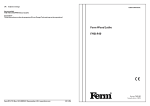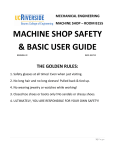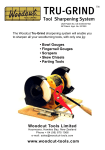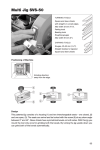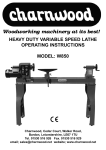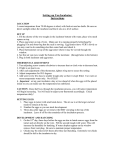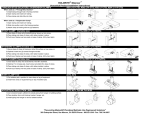Download WOOD LATHE GENERAL OPERATING INSTRUCTIONS
Transcript
WOOD LATHE GENERAL OPERATING INSTRUCTIONS A wood turning lathe can be dangerous if not used properly. If you are unsure as to how to proceed, ask.. Safety procedures to follow when using the wood lathe: • • • • • • • • • • • • • • • • Protect yourself from flying chips by wearing safety goggles or glasses that include side protectors or a full face shield. Do not wear gloves, loose clothing, rings or other jewelry or a neck tie around the neck that can hang outside of your clothing. Clothing should be comfortable but not so loose as to catch or get entangled on any of the rotating parts of the wood lathe. Shirts must be tucked in and long hair tied back. Do not leave the wood lathe unattended and on. Leave only after the lathe has been turned off and has come to a complete stop. Do not use makeshift tools not intended for wood turning Wear hearing protection that is suitable for the level and frequency of noise that you are exposed to in the wood turning area. Wear a dust mask particularly when sanding. Ensure that lighting is suitable for your operation. Prior to turning on the wood lathe, make sure that all clamps and fittings and tool rests are secure and that the work piece can turn freely. Rotate your workpiece by hand to make sure it clears the toolrest and bed before turning the lathe on. Always turn off the lathe to adjust the toolrest. Use wood stock that is free of defects and allow sufficient time for laminated stock to cure before using it. Ideally one should not use wood that has splits, checks, cracks or loose knots. Exercise caution with stock that has bark, knots or has an irregular shape or proturbances. While turners seek out wood stock that retains its bark, knots and other ‘defects’ which produce attractive and sometimes artistic turnings, bark, knots and irregular shape or proturbances checks and cracks require greater than usual caution. Know your capabilities and limitations. An experienced turner may be capable of techniques not recommended for the beginner. Hold tool(s) firmly and with both hands and on the tool rest. Fasten or hold the stock securely on the faceplate or between centres. • • • • • • • • • Use sharp well-maintained chisels and gouges. Do not use dull tools. Select a speed that is appropriate for the job. Remember that the bigger the piece, the slower the speed. Turn at low speed until the stock is round and use a moderate depth of cut so as to prevent splinters and chips from flying out during the roughing operation. Speed will be determined by the length of the stock and the diameter of the stock being turned and the nature of the work to be done and the type of tool used. Lathe speed should be established at a point where vibration is eliminated. Adjust the tool rest so that it is parallel and as close as possible to the stock. Adjust the tool rest so that tools will cut into wood slightly above the centre of the stock being turned. The tool being used occasionally requires that the tool rest be higher than the center point and farther away from the work piece eg. for a gouge or a skew . Remove tool rest when sanding or polishing. Different circumstances such as size and shape of turning require different methods of sanding. Use the appropriate sanding technique to the size and shape. Ensure that people do not lean or otherwise interfere with the safe operation of the lathe. When using a chuck always ensure that the tommy bars are removed before turning on the lathe. Keep the floor free and clear of clutter, obstructions and shavings. Do not use the lathe when you are tired or under the influence of drugs or alcohol Safety of yourself and those around you is your responsibility when you are turning. At the Club: Failure to observe these safety precautions will result in you being refused access to the lathe. Safety of yourself and those around you is your responsibility when you are turning. No outboard turning is permitted. prior approval of the President of the West Island Wood turners must be secured before hand.




